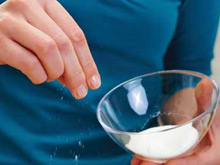 |
Hypertension or high blood pressure is a condition that usually catches up with age. There are several factors and conditions that are responsible for its development. Obesity, too much salt in the diet, stress, old age, lack of physical activity, family history and smoking are some of them. Uncontrolled high blood pressure leads to kidney disease, heart disease and even stroke. |
Dietary habits, weight watch and portion size go a long way in controlling blood pressure. Some dietary rules include:
- Controlling your salt or sodium intake.
- Include potassium (fruits, vegetables, dairy and fish), calcium (low fat and non fat dairy foods such as curd, milk and cheese), magnesium (green leafy vegetables, whole grains, seeds, nuts, dry peas and beans), fish oils (fatty fish such as salmon and mackerel) and garlic.
Salt Check!
- Keep track of the foods you eat, their portion size and sodium content.
- Aim for about less than 1 teaspoon of salt per day.
- Read the food package labels well and know their sodium content.
- Select foods that are low on sodium content.
- Try to avoid processed foods, fast food and canned food.
- Use salt-free seasonings for food preparations.
You can increase the intake of potassium, fibre and magnesium quite naturally by including apples, apricots, bananas, dates, grapefruit, green peas, melons, mangoes, oranges, pineapples, potatoes, spinach, strawberries, sweet potatoes, tuna and tomatoes in your diet.
|
DASH To Keep Hypertension At Bay
The DASH diet is said to be effective in controlling blood pressure. It is a diet where you have a certain number of daily servings from various food groups, while varying the number of servings on the basis of your caloric needs.
- Grains: Seven to eight daily servings (serving sizes: 1 slice of bread, 1/2 cup cooked rice/pasta, 28g of dry cereal)
- Vegetables: Four to five daily servings (serving sizes: 1 cup raw leafy greens, 1/2 cup cooked vegetable)
- Fruits: Four to five daily servings (serving sizes: 1 medium fruit, 1/2 cup fresh or frozen fruit, 1/4 cup dried fruit, 170g of fruit juice)
- Low-fat or fat-free dairy products: Two to three daily servings (serving sizes: 227g of milk, 1 cup curd and 42g of cheese)
- Lean meat, poultry and fish: Two or fewer servings a day (serving sizes: 85g of cooked meat, poultry or fish).
- Nuts, seeds, and legumes: 4-5 servings per week (serving sizes: 1/3 cup nuts, 2 tablespoon seeds, 1/2 cup cooked dry beans or peas)
- Fats and oils: 2-3 daily servings (serving sizes: 1 teaspoon vegetable oil or soft margarine, 1 tablespoon low-fat mayonnaise, 2 tablespoons light salad dressing)
- Sweets: Try to limit it to less than 5 servings per week (serving sizes: 1 tablespoon sugar or jelly/jam)
|
|
 |
Pinch Dr Harita Shyam is Consultant Gynaecologist & Obstetrician at Apollo Gleneagles Hospitals,Kolkata |
|